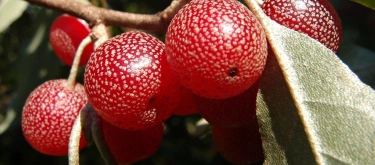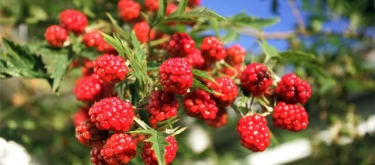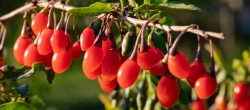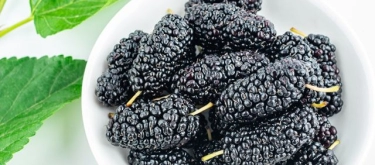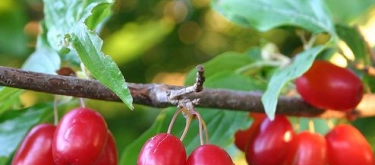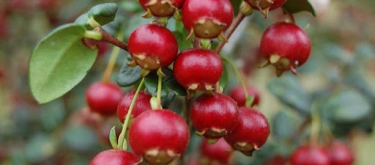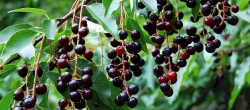Shepherdia (Buffaloberry): Taste Profile, Aroma, Benefits and Health Risks
Shepherdia, commonly known as buffaloberry, is a hardy shrub native to North America, valued for its small, vibrant berries. Traditionally used by Native American communities for both culinary and medicinal purposes, these berries have gained renewed interest for their nutritional benefits and unique flavor profile. Today, shepherdia finds its place in jams, jellies, sauces, and as a tangy accent in both sweet and savory dishes.
Shepherdia berries are naturally vegan, gluten-free, and suitable for most diets. They are not common allergens, though individuals sensitive to wild berries should exercise caution. Their astringent taste may not suit all palates, and moderation is advised due to high organic acid content.
What does Shepherdia (Buffaloberry) taste like?

Complete Sensory Description
Taste
Shepherdia berries deliver a distinctively tart and tangy flavor, underpinned by a pronounced astringency from naturally occurring tannins. When fully ripe, they reveal subtle hints of natural sweetness that balance the acidity, while underlying earthy and berry-like notes add complexity. This interplay creates a robust, invigorating taste that is both refreshing and slightly puckering, evoking the essence of wild, untamed fruit.
Aroma
Fresh buffaloberries exude a mild, fresh, and slightly vegetal aroma reminiscent of wild berries and crisp morning air. As they ripen, their scent deepens, offering hints of earthiness and a delicate tang that underscores their tart nature.
Texture
The texture of shepherdia berries is soft and juicy with a slightly granular feel due to tiny seeds and natural stone cells. While the flesh is succulent, the inherent astringency can leave a drying sensation on the palate, which is characteristic of many wild, high-tannin fruits.
Appearance
Vibrant in color, these berries range from bright red to deep crimson, set against silvery, hardy shrub foliage. Their small, oval shape and glossy skin make them visually striking, signaling both wild authenticity and natural resilience.
In-depth Flavor Analysis
At the molecular level, the bold flavor of shepherdia berries is driven by a blend of organic acids, tannins, and natural sugars. High levels of malic acid contribute to their sharp tartness, while lower concentrations of natural sugars (fructose and glucose) offer a delicate, balancing sweetness upon full ripening. Tannins impart the signature astringency, creating a drying sensation that enhances the fruit’s complexity.
The aroma is largely governed by volatile esters and terpenes, which evolve during ripening. Compounds such as ethyl acetate and hexyl acetate lend subtle fruity nuances, while trace amounts of phenolic compounds introduce earthy, herbal hints. Environmental factors—like soil composition, climate, and wild-growing conditions—further modulate these compounds, resulting in flavor variability among different populations. Additionally, traditional processing (e.g., drying or gentle cooking in jams) can reduce tannin levels and mellow the astringency, revealing richer, more rounded flavors.
Varieties and Culinary Applications
Varieties
- Shepherdia argentea:
Known as buffaloberry, these berries are often deep red, prized for their intense tartness and high vitamin C content. - Shepherdia canadensis:
Slightly milder in flavor, these berries offer a balanced tartness suitable for both raw consumption and processing.
Culinary Applications
- Fresh Consumption:
Enjoyed raw, often lightly sweetened to offset natural astringency, as part of wild fruit platters or salads. - Preserves and Jams:
Cooked into jams, jellies, or chutneys where heat treatment softens tannins and enhances natural sweetness, making them an excellent spread for bread or as a condiment. - Sauces and Marinades:
Incorporated into sauces or marinades for meats and cheeses, adding a tangy, complex flavor that complements rich, savory dishes. - Baked Goods:
Used in muffins, cakes, and pastries, where their tart profile provides a pleasant counterpoint to sweet batter. - Beverages:
Blended into smoothies, syrups, or cocktails to introduce a wild, tangy note.
Selection and Storage
Selecting Quality Shepherdia Berries
- Choose berries that are vibrantly colored, firm, and free from mold or excessive softness.
- Freshness is key: they should have a fresh, tangy aroma without any signs of fermentation or decay.
Storage Recommendations
- Refrigerate fresh shepherdia berries in a loosely covered container at temperatures below 4°C (39°F) and consume within 3–4 days.
- For longer preservation, consider drying or freezing the berries in airtight containers to maintain nutritional value and flavor integrity for up to 2–3 months.

Nutritional Insights
- High in Vitamin C:
Rich in vitamin C, which supports immune function, collagen synthesis, and antioxidant protection. - Dietary Fiber:
Provides dietary fiber that aids digestion and promotes gut health. - Antioxidants:
Abundant in antioxidants and polyphenols, which combat oxidative stress and inflammation. - Low-Calorie:
Naturally low in calories, making them an ideal nutrient-dense addition to balanced diets.
Expert Insights & Culinary Tips
- Balancing Astringency:
To mitigate the inherent astringency, pair shepherdia berries with natural sweeteners such as honey or maple syrup, or blend them with milder fruits. - Enhancing Flavors:
Use gentle cooking methods like low-heat simmering to reduce tannin intensity and unlock deeper, sweeter flavors in jams and preserves. - Culinary Pairings:
Combine with citrus fruits, fresh herbs (mint, basil), or tangy cheeses to create harmonious flavor profiles that complement both sweet and savory dishes. - Traditional Uses:
Explore traditional Native American recipes where these berries were valued not only for their taste but also for their medicinal properties.
Interesting and Curious Facts
- Shepherdia, commonly known as buffaloberry, has a rich history in Native American cultures, where it was used both as a food source and for its medicinal benefits.
- The berries are prized for their resilience and ability to thrive in harsh, wild environments, symbolizing natural abundance and survival.
- Traditional practices often involved drying the berries to preserve them for winter, making them a vital part of indigenous diets during lean seasons.
Harm and Dietary Considerations
- Astringency:
High tannin content can result in a pronounced astringent taste that may be off-putting to some; processing methods such as cooking can help mitigate this. - Digestive Sensitivity:
Overconsumption may lead to digestive discomfort due to the fruit’s high acidity and fiber content, so moderation is key. - Allergic Reactions:
Although rare, individuals with known sensitivities to wild berries or high-tannin fruits should exercise caution.
Religious Dietary Considerations
Shepherdia berries are universally acceptable across major religious dietary traditions:
- Islam: Permissible (Halal).
- Judaism: Permissible (Kosher, Parve).
- Hinduism & Buddhism: Widely permissible, traditionally included in various offerings and diets.
- Christianity & Other Religions: No known restrictions; widely enjoyed in diverse cultural contexts.
Final Thoughts & Sensory Journey
Shepherdia berries offer a bold, tangy flavor with vibrant acidity and natural astringency that make them truly unique. When processed into jams, sauces, or preserved for winter, they reveal a delicate balance of sweetness and tartness enriched by earthy undertones. Their robust, wild character and nutritional prowess continue to captivate culinary enthusiasts, bridging traditional heritage with modern gourmet innovation.
Resources
- McGee, H. (2004). On Food and Cooking: The Science and Lore of the Kitchen. Scribner.
- USDA FoodData Central (2023). Nutritional Composition of Wild Berries.
- Ethnobotanical Studies of Native American Edible Plants (various sources).
